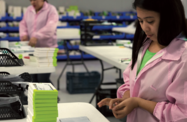In the Philippines’ current plans for a major upgrade of the country’s agricultural sector, the most dramatic move is a determination to transform the country from being the world’s top rice importer to becoming a net rice exporter by 2014.
This is undoubtedly a formidable task. Rice is the Philippines’ main food staple: in 2010, Filipinos consumed 112.76 kg of rice per year per capita compared to 16.17 kg per year per capita of corn, according to data compiled by the Bureau of Agricultural Statistics. Almost twice as much land was under cultivation for rice than corn in 2010, with rice taking up 4.4m ha and corn 2.5m ha.
Despite the challenges involved, however, when he took office in 2010, President Benigno S Aquino III declared that ensuring the country had adequate supplies of rice was among his foremost mid-term targets.
The administration has already made progress on this goal: in 2011, the country’s rice import requirement fell to 600,000 metric tonnes from 1.3m metric tonnes the previous year.
The government is aiming to build production from about 17m tonnes of palay (unhusked rice) in 2011 to 19m tonnes in 2012 and 21m tonnes in 2013. The Department of Agriculture thus estimates the country will have a surplus of rice by 2014, by which point it will be possible to export.
Indeed, in mid-December, the secretary of agriculture, Proceso Alcala, said that the country was on track to meet its goal of becoming self-sufficient in rice. Once this is achieved, becoming a regional purveyor of this staple crop to other countries in the region will be the next goal. South Korea and Japan will be the first markets the country will attempt to penetrate.
“After 2013, we will be self-sufficient. By 2014, we should not import anymore. We should start exporting,” Alcala told local media in December.
To achieve these ambitious goals, the government is spending a large slice of its P141.8bn ($2.1bn) 2012 budget on infrastructure projects in agriculture. Of this amount, the Department of Agriculture will receive P24.5bn ($355m), while the Department of Agrarian Reform will get P3.3bn ($48.4m). The funds will be spent on rural land transport links, agrarian post-harvest facilities and potable water supply and irrigation systems.
The funding for the agricultural sector’s undertaking to ensure rice self-sufficiency by 2013 is included in the 2012 budget, which outlines funding the Department of Agriculture’s National Rice Programme to the tune of P6.2bn ($90.6m) in 2012.
The government says the estimated yield necessary to attain rice self-sufficiency in 2013 is 21.1m metric tonnes. It intends to boost production via a variety of programmes and projects, including implementing more efficient irrigation systems, introducing high-quality seeds, stepping up research and development, managing pests and fertiliser use, encouraging organic farming methods, building and improving infrastructure, improving farm mechanisation to reduce post-harvest losses and issuing farmers with credit facilities.
Another strategy to bring about self-sufficiency includes managing rice consumption, with the Department of Agriculture looking at promoting alternatives to the traditional plate of white rice that many Filipinos are accustomed to consuming with their meals.
Corn grits are already a popular alternative staple to rice in Mindanao and the Visayas. In addition, brown rice, cassava and kamote – a type of sweet potato – could also be on the table for promotion as alternatives, thus taking some of the pressure off white rice as the country’s primary carbohydrate. The department has already expanded cassava production in provinces such as Sulu, Tawi-Tawi and Zamboanga.
The Department of Agriculture is also expanding the amount of arable land, opening up new areas for rice cultivation. Indeed, approximately 50% of the department’s 2012 budget is allocated to irrigation projects that will help farmers increase their land use and ultimately their output.
Of course, all this was planned before a series of typhoons causing terrible floods hit the Philippines in late 2011. Before that, in November 2011, the UN Food and Agriculture Organisation (FAO) had predicted that global paddy production in 2011 would weigh in at 721m tonnes – up 3% on 2010. The forecast was based on expected improved output from countries such as China, Bangladesh, Vietnam, India and Egypt.
In contrast, the Philippines joined Indonesia, Korea, Madagascar, Myanmar, Pakistan and Thailand as rice-growing countries that were expected to see deteriorating levels of rice production, so many will be watching to see if the country delivers on its ambitious goals this year.
One cause for hope is that climate change measures ordered by the Department of Agriculture, including flood mitigation, will go some way towards saving crops in the future. At the same time, although many parts of the country were hit by flooding in the last quarter of 2011, plenty of paddies were not affected. Viewed either way, the jury is still out on whether the Philippines will be shipping rice out of its ports in less than two years’ time.

